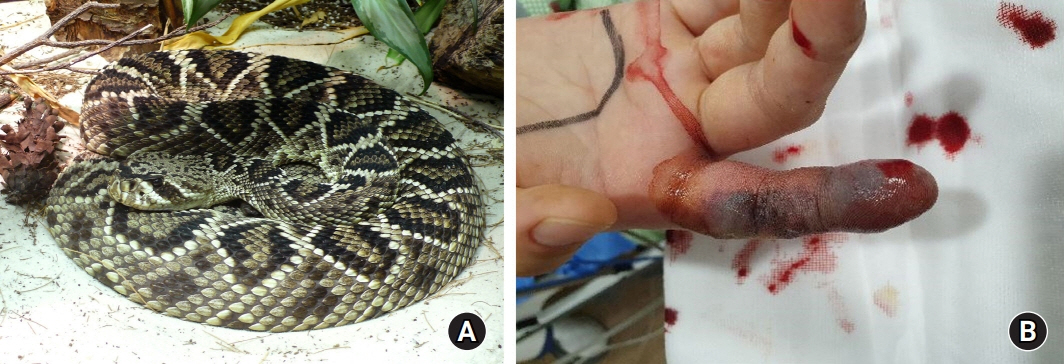Arch Hand Microsurg.
2022 Jun;27(2):161-165. 10.12790/ahm.22.0008.
Treatment of a rattlesnake bite on the finger using alternative antivenom management and reconstructive surgery: a case report
- Affiliations
-
- 1Department of Plastic and Reconstructive Surgery, Soonchunhyang University College of Medicine, Bucheon, Korea
- KMID: 2531923
- DOI: http://doi.org/10.12790/ahm.22.0008
Abstract
- Snake bite may be observed from localized symptoms to systemic complications. In most cases, the symptoms as well as the lab course improved by conservative treatment. Therefore, it is recommended that enough of the antivenom be administered initially, and the hospital should be aware of the most common envenomations to obtain the most needed antivenoms. A case of 22-year-old woman bitten on her finger by a Estern Diamondback Rattlesnake. In Korea, there is no antivenom for rattlesnake, so freeze-dried Agkistrodon halys Antivenom was used alternatively. After 10 days of the injury, laboratory finding was almost normalized. At that time, the digit had undergone massive skin necrosis. The wound achieved total healing at postoperative 2 months after flap coverage. This case of rattlesnake bite, which was first described in Korea, present a management with antivenom to other family of snake, and successful surgical treatment.
Keyword
Figure
Reference
-
References
1. Lim H, Kang HG, Kim KH. Antivenom for snake bite in Korea. J Korean Med Assoc. 2013; 56:1091–103.
Article2. Ruha AM, Kleinschmidt KC, Greene S, et al. The epidemiology, clinical course, and management of snakebites in the North American Snakebite Registry. J Med Toxicol. 2017; 13:309–20.
Article3. Walter FG, Stolz U, Shirazi F, McNally J. Epidemiology of severe and fatal rattlesnake bites published in the American Association of Poison Control Centers' Annual Reports. Clin Toxicol (Phila). 2009; 47:663–9.
Article4. World Health Organization (WHO). Snakebite envenoming [Internet]. Geneva: WHO;2021. [cited 2022 Mar 7]. Available from: https://www.who.int/news-room/fact-sheets/detail/snakebite-envenoming.5. Choi HJ, Lee DW, Ryu HR, Kim JH, Lee JH. Case of treatment of snakebite on finger with topical oxygen therapy. Arch Hand Microsurg. 2020; 25:292–6.
Article6. Corbett B, Clark RF. North American snake envenomation. Emerg Med Clin North Am. 2017; 35:339–54.
Article7. Mascarenas DN, Fullerton L, Smolinske SC, Warrick BJ, Seifert SA. Comparison of F(ab’)2 and Fab antivenoms in rattlesnake envenomation: first year’s post-marketing experience with F(ab’)2 in New Mexico. Toxicon. 2020; 186:42–5.
Article8. Gao JF, Wang J, Qu YF, Ma XM, Ji X. Immunoreactivity between venoms and commercial antiserums in four Chinese snakes and venom identification by species-specific antibody. J Immunol Methods. 2013; 387:211–8.
Article9. Lavonas EJ, Ruha AM, Banner W, et al. Unified treatment algorithm for the management of crotaline snakebite in the United States: results of an evidence-informed consensus workshop. BMC Emerg Med. 2011; 11:2.
Article
- Full Text Links
- Actions
-
Cited
- CITED
-
- Close
- Share
- Similar articles
-
- Replantation for Amputation of the Finger by a Dog Bite
- A Case of Paralytic Strabismus after a Snake Bite on the Toe
- Antivenom for snake bite in Korea
- A case Report of Hyponatremia Resulting from Treatment of Anaphylaxis and Rhabdomyolysis in a Snake Bite Patient
- Mallet Deformity of Distal Phalanx of Index Finger after Snake Bite





